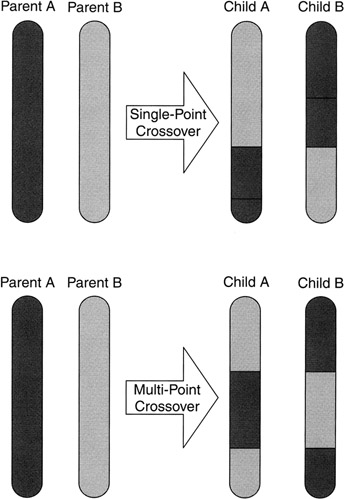Genetic Operators
While the variety of genetic operators is quite large, only a handful are useful in general problems. The operators discussed below, crossover and mutation, are direct descendents of natural mechanisms.
Crossover
The crossover operator takes two chromosomes, separates them at a random site (in both chromosomes) and then swaps the tails of the two, resulting in two new chromosomes. Cutting the chromosome at one location, called single-point crossover is not the only possibility. Multi-point crossover can also be used (see Figure 6.7).

Figure 6.7: Single and multi-point crossover.
The crossover does not create new material within the population, but simply intermixes the existing population to create new chromosomes. This allows the genetic algorithm to search the solution space for new candidate solutions to solve the problem at hand. The crossover operator is generally accepted as the most important operator. While it is important, the next operator provides for the introduction of new material within the population.
Mutation
The mutation operator introduces a random change into a gene in the chromosome (sometimes more than one, depending upon the rate of application). The mutation operator provides the ability to introduce new material into the population. Since chromosomes simply intermix with existing chromosomes, mutation provides the opportunity to "shake-up" the population to expand the solution space (see Figure 6.8).

Figure 6.8: Mutating a single chromosome.
EAN: 2147483647
Pages: 175